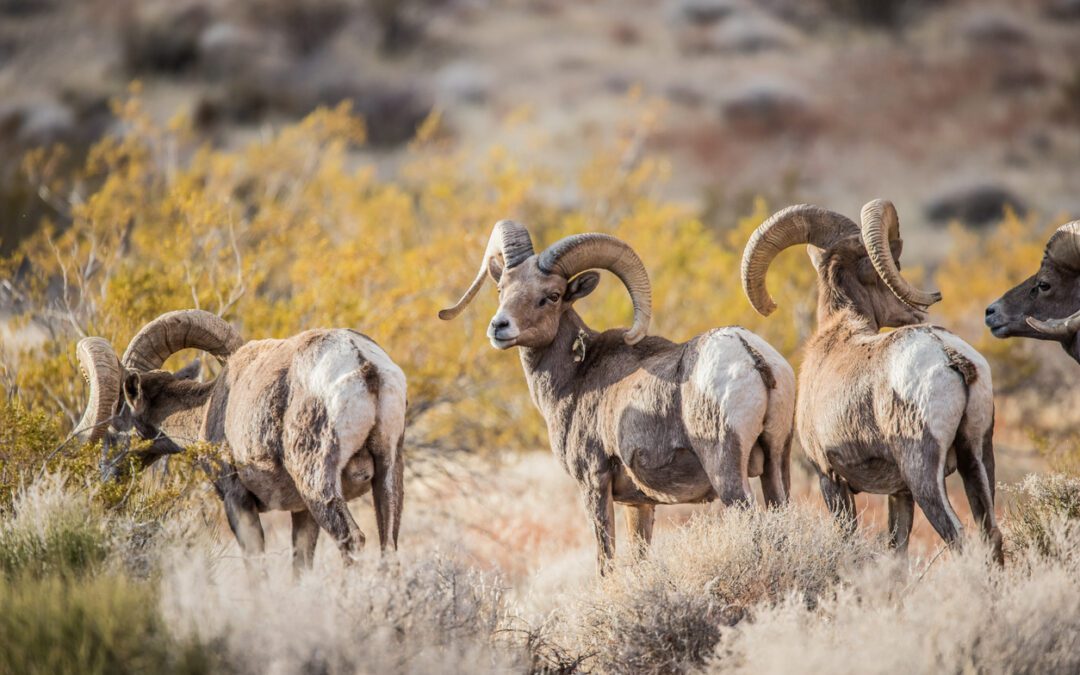There’s a saying we have here in Utah that no matter what type of “outdoorsy” you are, there’s something for you here. Whether you prefer mountains or desert, skiing or boating, hunting or fishing, rivers or lakes, Utah has a diverse landscape to choose from. This is also why there are multiple regions in which you can find bighorn sheep in Utah.
Where Are There Bighorn Sheep in Utah?
Utah’s bighorn sheep are found in the deserts of Southern Utah as well as the Wasatch Mountains. Some good viewing areas include:
- Flaming Gorge
- San Rafael Swell
- Zion National Park
- Wasatch Mountains
- Antelope Island
- Book Cliffs
- Newfoundland Mountains
- Moab
- Arches National Park
- Dead Horse Point State Park
Early explorer records tell us that over 2 millions desert bighorn sheep once roamed the southwest. By the late 1800’s, bighorn sheep had disappeared or declined in many areas of Utah due to over-hunting, predation, and disease passed from livestock. Due to conservation efforts, such as those by the Utah Wild Sheep Foundation, you can now find bighorn sheep in Utah in multiple regions.
As always, be sure to view bighorn sheep in Utah from a respectful distance–and remember that patience often pays off when trying to view these creatures.
When is the Best Time to See Bighorn Sheep in Utah?
The best time to see bighorn sheep in Utah is in the late fall through early winter. This is because bighorn sheep during that time are in rut (or breeding season). This means they are more likely to allow vehicles to get closer since they’re more occupied in courtship activities. It is also when they are more likely to clash heads and fight for dominance.
Utah’s bighorn sheep breeding season includes August through November for desert bighorn sheep and October through January for Rocky Mountain and California bighorn sheep.
What Types Of Bighorn Sheep Live in Utah?
There are three primary types of bighorn sheep that are native to Utah: Rocky Mountain Bighorns, California Bighorns, and Desert Bighorns. They vary in size and habitat.
Desert Bighorn Sheep
Desert bighorn sheep, also called Nelson’s bighorn sheep, are the more common type of bighorn sheep in Utah. Desert bighorns have adapted to hot, dry climates. They have longer legs, lighter coats, and smaller bodies than other bighorn sheep in Utah. They roam throughout the desert and mountains of southeast Utah. You can find desert bighorns in these areas:
- San Rafael
- Potash (around Moab)
- Canyonlands
- Little Rocky Mountains
- Escalante
- Kaiparowits Desert
- San Juan Desert
- Muddy Mountains
- Pine Valley
- Beaver Dam
- Zion National Park
Rocky Mountain Bighorns
Rocky Mountain bighorns reside in parts of the Wasatch Mountains, Avintaqiun, the north slope of Uinta Mountains, Flaming Gorge, the Book Cliffs, Desolation Canyon, Pilot Mountain, and Antelope Island. Rocky Mountain bighorn sheep are the largest wild sheep in North America. Males can weigh over 300 pounds and stand three feet tall at the shoulder. Females are roughly half the size.
California Bighorns
California bighorn sheep prefer Utah’s mountainous areas where they can eat grasses, sagebrush, sedges and forbs. The California bighorn may have been native to Utah in ancient times, but if so, it wasn’t here by the time Europeans arrived. California bighorns can be found on a few small ranges in Central and Northern Utah. California sheep can be found in the Newfoundland Mountains, Stansbury Mountains, and the Oak Creek Mountains. California and Rocky Mountain bighorns are genetically the same species but the state of Utah manages the two as different species. They’re smaller than the Rocky Mountain bighorns and weigh around 160-250.
Final Thoughts
Bighorn sheep can live in diverse environments from the rocky desert areas to the cold mountainous climates. Bighorn sheep tend to seek terrain that provides safety from the dangerous eliminates that the wilderness provides.
Throughout our history, the population of bighorn sheep has been eliminated drastically since the 1900s. The Utah Wild Sheep Foundation was founded in 1991, and with the help of some amazing volunteers, we have been able to save the bighorn sheep population in Utah. If you’d like to help the efforts to keep Bighorn Sheep on Utah mountains, please consider joining Utah Wild Sheep Foundation or donating today.
Utah Wild Sheep Foundation is a 501(c)(3) nonprofit organization.

